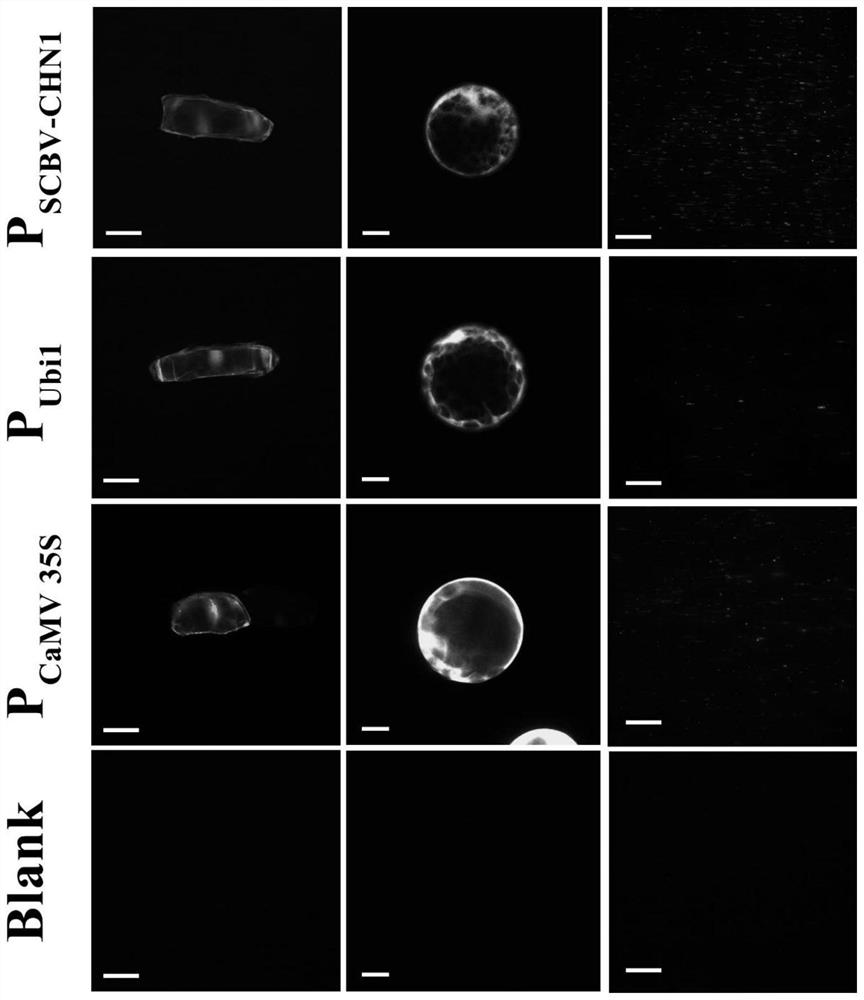Constitutive promoter PSCBV-CHN1 from sugarcane baculovirus and application thereof
A PSCBV-CHN1, promoter sequence technology, applied in the field of plant genetic engineering and plant genetic breeding, can solve the problems of narrow genetic background, laborious, limited genotype, etc.
- Summary
- Abstract
- Description
- Claims
- Application Information
AI Technical Summary
Problems solved by technology
Method used
Image
Examples
Embodiment 1
[0047] Example 1 Cloning of SCBV-CHN1 Promoter Nucleotide Sequence
[0048] 1-1 Experimental Materials
[0049] Leaf samples of sugarcane cultivar ROC27 infected with SCBV-CHN1 were collected from Fujian, China. The leaves were collected from sugarcane + 1 leaf in the sugarcane field (the highest visible hypertrophy with leaves), brought back to the laboratory, cleaned and disinfected with 75% alcohol, placed in a ziplock bag, and stored in an ultra-low temperature refrigerator at -80°C.
[0050] 1-2 Extraction of total DNA from sugarcane leaves
[0051] The extraction method of total DNA from sugarcane leaves adopts the modified CTAB method (Sun et al., 2016). The absorbance and concentration of total DNA were measured by NanoVue ultra-micro spectrophotometer (GE Healthcare) protein nucleic acid analyzer, and the integrity of total DNA was detected by electrophoresis.
[0052] 1-3 SCBV-CHN1 Genome Cloning
[0053] According to the two SCBV genome sequences published in th...
Embodiment 2
[0056] Example 2 P SCBV-CHN1 Construction of promoter plant recombinant expression vector
[0057] 2-1 Construction of EYFP expression vector
[0058] Preparation of plant expression vector backbone: using fast restriction endonucleases XhoI and NcoI (Fermentas, USA) to CaMV 35S : The EYFP vector was digested, and the 25 μL double-enzyme digestion reaction system contained 2.5 μL 10×FastDigest Buffer, 0.5 μL XhoI, 0.5 μL NcoI and 1 μg target plasmid. After 30 min in a water bath at 37°C, electrophoresis was performed on a 1% agarose gel to recover a large fragment, ie, the target vector backbone, and stored in a -20°C refrigerator for later use.
[0059] PCR amplification: Design the amplification promoter P by the seamless cloning primer design tool (http: / / 123.56.75.195 / ) SCBV-CHN1 Sequences of primers IF-EYFP-CHN1-F: 5'-CGGGCCCCCCCTCGAGAAGAACCAACTCTGCTATGTGCATG-3' (SEQ ID NO: 6) and IF-EYFP-CHN1-R: 5'-CCCTTGCTCACCATGGCAAAGAGCTCAAATGATCAGCTG-3' (SEQ ID NO: 7). pass The...
Embodiment 3
[0063] Example 3 P SCBV-CHN1 : Transient expression of EYFP plasmid in onion epidermal cells, Arabidopsis protoplasts and sugarcane young leaf tissue
[0064] 3-1 Preparation of onion scale epidermis and plasmid transformation
[0065] Wash the onion with sterile water, soak it in 75% alcohol for 1 min; remove the top and base of the onion and cut the two outer layers of onion scales; cut the onion in half four times, take the outer three layers, tear off the inner skin of the onion scales, and cut into about 2cm 2 Square sheet, place its smooth side up and inner surface down in MS osmotic medium (4.4g / L MS medium base salt (with vitamins), 36.4g / L mannitol, 0.6mg / L 2,4 -D, 6g / L agar powder, pH 5.8~6.2). The osmotic medium on which the onion scale epidermis was placed was placed in a dark place and incubated at 28°C for 4 h for use. put P SCBV-CHN1 : The EYFP plasmid is coated in tungsten powder (1.1 μm), the specific operation steps refer to Gao et al. (2013), the bombar...
PUM
 Login to View More
Login to View More Abstract
Description
Claims
Application Information
 Login to View More
Login to View More - R&D Engineer
- R&D Manager
- IP Professional
- Industry Leading Data Capabilities
- Powerful AI technology
- Patent DNA Extraction
Browse by: Latest US Patents, China's latest patents, Technical Efficacy Thesaurus, Application Domain, Technology Topic, Popular Technical Reports.
© 2024 PatSnap. All rights reserved.Legal|Privacy policy|Modern Slavery Act Transparency Statement|Sitemap|About US| Contact US: help@patsnap.com










